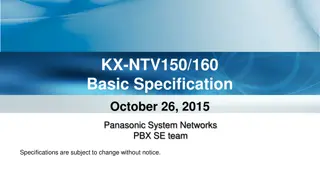
Decoding Management Accounting: An Overview by Dr. S. Bellarmin Diana
Explore the fundamentals of management accounting through an insightful introduction by Dr. S. Bellarmin Diana, covering financial accounting, cost accounting, and management accounting. Discover the significance of accounting in providing vital financial information for effective decision-making and resource management within organizations.
Download Presentation

Please find below an Image/Link to download the presentation.
The content on the website is provided AS IS for your information and personal use only. It may not be sold, licensed, or shared on other websites without obtaining consent from the author. If you encounter any issues during the download, it is possible that the publisher has removed the file from their server.
You are allowed to download the files provided on this website for personal or commercial use, subject to the condition that they are used lawfully. All files are the property of their respective owners.
The content on the website is provided AS IS for your information and personal use only. It may not be sold, licensed, or shared on other websites without obtaining consent from the author.
E N D
Presentation Transcript
MANAGEMENT ACCOUNTING -An Introduction Dr.S.BELLARMIN DIANA ASSISTANT PROFESSOR PG & RESEARCH DEPARTMENT OF MANAGEMENT STUDIES BON SECOURS COLLEGE FOR WOMEN, THANJAVUR.
INRODUCTION Accounting serves the purpose of providing financial information relating a business. Such information is provided to people who have an interest in the organization On the basis of type of accounting information and the purpose for which such information is used, accounting may be divided into three categories: Accounting Financial Accounting Cost Accounting Management Accounting
Financial Accounting Financial accounting is mainly concerned with recording business transactions in the books of accounts for the purpose of presenting final accounts, i.e., Profit & Loss account - showing the net profit or loss during the period Balance Sheet - showing the financial position of the firm at a point of time. The objective of financial accounting is to provide information to external parties such as shareholders, creditors, employees, potential investors, government agencies, etc.
Cost Accounting Cost accounting is a branch of accounting which specializes in providing information about the detailed cost of products or services being supplied by the undertaking. The information supplied by cost accounting acts as a tool of management for making optimum use of scarce resources and ultimately-add to the profitability of business. Cost accounting information is mainly for internal use i.e. management. It is not to be provided to external parties such as shareholders, creditors, potential investors, etc.
Management Accounting It is concerned with all such accounting information that is useful to management. In simple words, the term management accounting is applied to the provision of accounting information for management activities such as planning, controlling and decision-making, etc. It serves as a decision support system to all levels of management.
DEFINITION According to National Association of Accountants (USA), management accounting is "the process of identification, measurement, accumulation, analysis, preparation and communication of financial information used by management to plan. evaluate and control within the organization and to assure appropriate use and accountability for its resources.
DEFINITION In the words of Robert Anthony, "Management accounting is concerned with accounting information that is useful to management. The Institute of Cost and Works Accountants of India (ICWAI) has defined management accounting as "a system of collection and presentation of relevant economic information relating to an enterprise for planning, controlling and decision making."
OBJECTIVES To assist the management in promoting efficiency To prepare budgets covering all functions of a business To analyze monetary and non-monetary transactions To compare the actual performance with plan for identifying deviations and their causes
OBJECTIVES To interpret financial statements to enable the management to formulate future policies To submit to the management at frequent intervals operating statements and short-term financial statements. To arrange for the systematic allocation of responsibilities To help the management in making decisions and implementing them efficiently
CHARACTERISTICS The aim of management accounting is to assist management in decision making Management accounting derives basic accounting information from financial and cost accounting The information provided by management accounting is used by management for internal use and its is not given to external parties Its adoption by any firm is depends on its utility and desirability and there is no statutory obligation As it is concerned with decision making it is related with future course of action There is no prescribed formats for presentation of information to management. The study of cause and effect relationship is possible in management accounting
SCOPE OF MANAGEMENT ACCOUNTING For an effective and successful management accounting, there should be a proper and well designed financial accounting system The techniques of cost control and techniques of profit planning and decision-making are used by the management accounting Forecasting helps in the preparation of budgets and budgeting helps management accountant in exercising budgetary control Management accountant depends upon tax accounting and planning to minimize its tax liabilities and save more funds for the business
SCOPE OF MANAGEMENT ACCOUNTING For effective and timely decisions, there should be a system of prompt and intelligent reporting to management Management accounting is incomplete without effective cost control procedures like inventory control, labour control, overhead control, budgetary control, etc Tools of analyzing and presenting 'statistical data like graphs, tables, charts, etc., are used in preparing reports for use by the management
SCOPE OF MANAGEMENT ACCOUNTING Management accountant heavily depends on internal financial controls like internal audit and internal check to plug loop holes in the financial system of the concern Management accountant employs various techniques to analyze and interpret financial data to make it understandable and useable to the management Management accountant is expected to maintain and control office routines and procedures like filing, copying, communicating, electronic data processing and other allied services
FINANCIAL ACCOUNTING VS MANAGEMENT ACCOUNTING FINANCIAL ACCOUNTING MANAGEMENT ACCOUNTING Accounting intended for external users information is mainly Accounting information is mainly meant for internal users It is based on double entry system It is not based on double entry system It is obligatory under company law and tax law It is optional It shows the profit or loss of the business as a whole and does not show the cost and profit for individual products, process or departments It provides detail information about individual products, departments plants or
FINANCIAL ACCOUNTING VS MANAGEMENT ACCOUNTING MANAGEMENT ACCOUNTING FINANCIAL ACCOUNTING It is future oriented and concentrates on what is likely to happen in future. It is concerned with recording transactions which have already taken place Financial reports are prepared usually on a year to year basis Accounting reports are prepared frequently It is not bound by accounting standards Financial accounts are prepared according to accounting standards issued by ICAI It prepares special purpose reports which are used by top level management It prepares general purpose statements which are used by external users Accounting statements are neither published for general public nor required to be audited by the Charted Accountants Financial statements are published for general public and are required to be audited by the Charted Accountants It provides information in terms of money only It may apply monetary and non-monetary units of measurement
COST ACCOUNTING VS MANAGEMENT ACCOUNTING COST ACCOUNTING MANAGEMENT ACCOUNTING It provides cost as well as financial accounting information It provides only cost information The main emphasis is on planning, controlling and decision making to maximize profit The main emphasis is on cost ascertainment and cost control to ensure maximum profit Evolution of cost accounting is mainly due to the limitation of financial accounting Evolution of management accounting is due to the limitations of cost accounting Maintenance of cost records has been Management accounting is purely made compulsory in selected industries as notified by the Govt. from time to time Management accounting is purely voluntary and its use depends upon its utility to management
COST ACCOUNTING VS MANAGEMENT ACCOUNTING COST ACCOUNTING MANAGEMENT ACCOUNTING It is based on data derived from cost accounting and financial accounting and other sources It is based on data derived from financial accounts In the organizational setup, cost accounting is placed at lower level in hierarchy than the management accountant Management accountant is generally placed at a higher level of hierarchy than the cost accountant Management accounting can not be installed without a proper system of cost accounting Cost accounting system can be installed without management accounting Management accounting also uses all these techniques used in cost accounting but in addition it also uses techniques like ratio analyses funds flow statement, statistical analysis and certain techniques from various branches of knowledge Various techniques used by cost accounting include standard costing and variance analysis, marginal costing andcost volume profit analysis, budgetary control, uniform costing comparison, etc. and inter-firm
TOOLS & TECHNIQUES Responsibility accounting Budgeting Accounting for price level changes Standard costing and variance analysis Statistical and graphical techniques Marginal costing and cost volume profit analysis Discounted cash flow Ratio analysis Risk analysis Comparative financial statements Learning curve Differential cost analysis Value analysis Funds flow statements Work study, etc Cash flow statement




